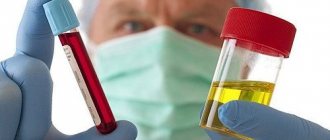Bacteriuria is a pathological condition characterized by the excretion of bacteria in the urine. If their number reaches 105 in 1 ml of liquid, this indicates the presence of microbial flora in the organs of the urinary system. Bacteria in the urine during pregnancy is a sign of infection of the kidneys, bladder or urinary tract. For diagnosis, urine culture and photocolorimetric TTX test are used. Treatment of women during pregnancy is carried out with low-toxic antibiotics and herbal uroseptics.
Types of bacteriuria
In 80% of cases, bacteriuria is provoked by microorganisms that always inhabit the distal (end) section of the urethra. In 2/3 of women, the microbial flora is represented by:
- Proteus;
- enterobacter;
- pyogenic streptococcus;
- saprophytic staphylococcus;
- klebsiella;
- coli;
- Citrobacter.
Most often, bacteriuria occurs in women during pregnancy, which is associated with a natural decrease in immune defense, changes in the chemical composition of urine, or its stagnation in the urinary organs.
There are 2 forms:
- True. Accompanied by changes in the functioning of the urinary system, as indicated by characteristic symptoms - urinary disorders, fever.
- False (asymptomatic). It is detected only in the laboratory during a general urine test.
Asymptomatic bacteriuria during pregnancy occurs 3 times more often. It affects women suffering from nephrolithiasis, bacterial vaginosis, and diabetes mellitus.
Most often, bacteria in urine are detected in the 2nd and 3rd trimesters of pregnancy. As the fetus enlarges, the urinary ducts are compressed or displaced, which leads to impaired urodynamics and stagnation of urine in the bladder and kidneys.
Causes of increased protein in urine
Mild proteinuria can occur for a completely harmless reason. You are too tired after prolonged physical activity, have experienced stress, or have overeaten foods rich in protein compounds. Even simple hypothermia can increase protein in the urine.
Physiologically, albumin can occur when the kidneys change their position due to changes in the spine or pressure from the uterus. Another negative factor is dehydration, which develops as a result of insufficient water intake or excessive sweating. Usually, when retesting, traces of protein are not detected in this case.
Protein content above 3 g/l is due to the following reasons:
- Pyelonephritis in pregnant women.
This is inflammation in the kidneys. It occurs when the movement of urine through the urinary tract is disrupted, and microbes begin to multiply in them.
- Glomerulonephritis.
Infectious lesion of the glomerular apparatus of the kidneys. The main pathogens are streptococcus and staphylococcus.
- Renal cyst.
A formation on the surface of the kidney filled with fluid. It develops during pregnancy if a woman drinks alcohol, smokes, is constantly in contact with harmful chemicals, or has been exposed to x-rays.
- Stones in the kidneys or bladder.
They are formed when water-salt metabolism is disrupted, as a result of stress and due to unfavorable heredity.
- Preeclampsia.
Severe syndrome of the 3rd trimester of pregnancy, when a woman’s body ceases to cope with the tasks of providing the fetus with the necessary nutrition and oxygen.
Pathways for microorganisms to enter urine
In half of the cases, bacteriuria in pregnant women is the result of an insufficient immune response to the proliferation of opportunistic bacteria. Normally, the kidneys and bladder are sterile. Representatives of normal microflora inhabit only the end section of the urethra. But if the pH of the urine changes or the body’s immunity decreases, they begin to multiply and colonize other parts of the urinary system.
The main ways bacteria enter urine are:
- Rising. Microorganisms enter the bladder and kidneys from the urethra.
- Descending. The infection enters the urethra from the kidneys, ureters and bladder. This route of infection is possible with relapses of urological diseases - ureteritis, cystitis, pyelitis, pyelonephritis.
- Hematogenous. Bacteria enter the urine from distant foci of infection through the bloodstream. Therefore, bacteriuria is more often found in pregnant women who have had acute respiratory viral infections, tonsillitis, or bacterial rhinitis.
- Lymphogenic. The infection enters the urinary system through lymphatic vessels from distant foci of inflammation.
Bacteria usually enter the urinary organs through a relaxed urethral sphincter. Due to decreased immunity during pregnancy, classic inflammation in the end section of the urethra does not occur. Therefore, microorganisms almost freely enter the bladder, ureters and kidneys.
Causes of bacteriuria in pregnant women
To find out why bacteriuria appeared, you need to undergo a comprehensive examination by a urologist. The presence of bacteria in the urine during pregnancy indicates poor health of the genitourinary system.
Microbial flora provokes complications that negatively affect the body of the expectant mother and fetus.
Cystitis
Very often, bacteriuria during pregnancy occurs against the background of cystitis - inflammation of the bladder. In 86% of women, the pathology is provoked by Escherichia coli. Possible pathogens include Klebsiella, enterococcus, and streptococcus. In some women, bacteria in urine are the result of sexually transmitted infections:
- ureaplasmosis;
- candidiasis;
- gonorrhea;
- chlamydia.
The proliferation of microbial flora in the urine is provoked by hypothermia, dysbacteriosis, metabolic disorders, and hypovitaminosis.
Urethritis
Inflammation of the urethra is a common cause of an increase in the number of bacteria in the urine. In 82% of cases, a pregnant woman is diagnosed with secondary urethritis, provoked by:
- genitourinary infections;
- urinary catheterization;
- vitamin and mineral deficiency;
- urolithiasis;
- unbalanced diet.
With urethritis, opportunistic and pathogenic bacteria are found in the urine - chlamydia, E. coli, gonococci, Proteus.
Pyelonephritis
Gestational pyelonephritis is an infectious inflammation of the kidneys, predominantly of a bacterial nature. Occurs in 7-10% of women in the 2nd and 3rd trimesters of pregnancy. The disease is provoked by opportunistic bacteria that colonize the urethral area.
With bacterial pyelonephritis, the concentration of microbes in the urine exceeds 105 per 1 ml. In half of the cases, kidney inflammation occurs against the background of gynecological diseases - bacterial vaginosis, vulvitis, endocervicitis.
During pregnancy, changes occur in the female body that lead to stagnation of urine. An increase in pressure in the urinary system leads to dilation of the renal pelvis. As a result, conditions are created that are favorable for the growth of bacteria.
Other reasons
Bacteria in urine during pregnancy can be detected as a result of many negative factors. The appearance of microbial flora in the urinary system is facilitated by:
- physical inactivity;
- secondary immunodeficiencies;
- pelvic organ injuries;
- decreased urinary tone;
- gestational diabetes;
- ENT infections;
- lack of personal hygiene;
- wearing tight underwear;
- varicose veins;
- congenital anomalies of the urinary organs.
Women suffering from pyelitis, vesicoureteral reflux, urolithiasis, and diabetes are susceptible to bacteriuria.
Being a preclinical form of a number of diseases of the urinary system, asymptomatic bacteriuria (AS), according to numerous studies, is the leading form of urinary tract infection (UTI) in pregnant women [1-3]. To diagnose BD, it is recommended to use the following criteria: isolation of the same type of bacteria in an amount of ≥ 105 CFU/ml in 2 consecutive urine cultures with an interval of more than 24 hours, obtained from pregnant women without signs of UTI; absence of clinical signs of infection; leukocyturia (possible) [4, 5]. Currently, with the highest level of evidence (A), it has been established that treatment of pregnant women with BD in the standard diagnostic titer of bacteria in the urine (≥105 CFU/ml) leads to a significant reduction in the risk of complications in both the mother and the fetus [6-8 ]. However, the standard diagnostic criterion of bacteriuria ≥105 CFU/ml has been criticized as being too high for pregnant women. This approach is justified by the results of single studies, according to which, even at a degree of bacteriuria in the urine of pregnant women of 102-104 CFU/ml, an increased incidence of obstetric, neonatal and urological complications is observed [4, 9].
Material and methods
We examined 809 pregnant women who were observed in the antenatal clinic of the State Budgetary Healthcare Institution Clinical Hospital No. 1 of Smolensk from October 2009 to December 2011, in order to identify BD. All women were examined for bacteriuria three times during pregnancy: at first presentation (up to 12 weeks), at 22-24 weeks of pregnancy, and before admission to the maternity hospital. Screening was carried out by semi-quantitative assessment of the intensity of bacteriuria using Uricult trio submersible slides, which are plates coated with nutrient media. In addition to screening, a comprehensive examination of patients was carried out in accordance with order No. 808n of the Ministry of Health and Social Development of the Russian Federation dated 10/02/09.
175 pregnant women who made up the main group were diagnosed with BD, and depending on the therapy and the form of BD, two groups were divided: 1st - 81 pregnant women and 2nd - 94; Group 1 was divided into two subgroups: subgroup 1a consisted of pregnant women with a traditional diagnostic BB titer (≥ 105 CFU/ml), antibacterial therapy for which was carried out according to the study protocol (drugs of amoxicillin clavulanate and cefixime in a 1:1 ratio); subgroup 1b - patients with untreated BD. The 2nd group consisted of women diagnosed with a low degree of BD (102-104 CFU/ml), who were not treated due to the low titer of bacteria. The remaining 634 women who did not have BD formed the control group. Considering that 37 pregnant women had a termination of pregnancy in the period from 10 to 24 weeks, at the stage of analysis of labor and the postpartum period, the volume of the examined contingent included 772 postpartum women: group 1 - 75 women, subgroup 1a - 61, 1b - 14, 2- group I - 86, control group - 611. The total number of newborns was 778, which is explained by the following reasons: in subgroup 1a, after a spontaneous miscarriage, the fetus lived for more than 168 hours and was transferred to the status of a newborn; there was 1 case of intranatal death of one of the twin fetuses. In subgroup 1b, antenatal fetal death was recorded in 2 pregnant women. In the control group, there was also 1 case of antenatal fetal death; there were twins in 7 pregnant women. In the group with a low degree of BD, 1 twins were observed, and there were no perinatal losses. Thus, the newborns were distributed into groups as follows: in 1a - 62, in 1b - 12, in 2nd - 87 and in the control group - 617 children.
results
Some features of the course of pregnancy depending on the therapy and the form of BD that deserve special attention are reflected in Table. 1.
Thus, the threat of miscarriage was a fairly common complication in patients of all groups. The peak manifestation of this pathology was determined in the second trimester of pregnancy. In women with the traditionally interpreted BD of subgroup 1a who were treated with antibiotics, as pregnancy progressed, the clinical manifestations of the threat of its termination decreased by 2 times. A similar situation was observed in the control and group with a low degree of BD (group 2), where the decrease was 1.9 and 1.7 times, respectively. In untreated patients of subgroup 1b, there was practically no reduction in the number of cases of threatened miscarriage: in 31.6% of women at 13-28 weeks and in 26.3% of patients after 28 weeks, i.e. decreased only 1.2 times.
The number of cases of exacerbation of pyelonephritis and cystitis in subgroup 1a with treated BD and in the control group was 9.7 and 4.3%, respectively; no significant differences were found between these indicators. As would be expected, pregnant women in subgroups 1b and 2 had a significantly greater number of episodes of exacerbation of pyelonephritis and cystitis compared to those in the control group: in subgroup 1b - 36.8% (p<0.001); in group 2 - 30.9% (p<0.001).
Rates of miscarriage deserve special attention. Thus, in subgroup 1b, 26.3% (p<0.001) (i.e., every fourth) experienced a non-developing pregnancy in the period from 8 to 14 weeks, which exceeded the corresponding figure in the control group (2.5%) in 10. 5 times! Timely antibiotic therapy helped prevent this pregnancy complication in subgroup 1a, but did not exclude complications such as spontaneous miscarriage (1.6%). As for pregnancy occurring against the background of a low degree of BD, the number of cases of non-developing pregnancy in this group was 6.4% (p<0.05), and spontaneous miscarriage occurred in 2.1% of patients.
In subgroup 1a, despite the therapy, there was a high percentage of polyhydramnios, twice as high as in the control group (6.5 and 3.2%), but the differences were statistically insignificant. In subgroup 1b and group 2, where treatment for asymptomatic uroinfection was not carried out, the number of cases of polyhydramnios was three times higher than the general population figure, but the difference with the control group was significant only in group 2 (with a low degree of BD) - 9.6% ( p<0.01). The high frequency of polyhydramnios is a fact indicating in favor of inflammatory damage to the fetoplacental complex (FPC).
Manifestations of chronic fetoplacental insufficiency (CPI) and chronic fetal hypoxia (CHF) were significantly more common in the main group compared to the corresponding indicators in the control group. However, the proportion of manifestations of FPC lesions in subgroups 1a, 1b and in group 2 was different. The lowest percentage of CGP and CPRF in the main group was determined in patients with treated BD (subgroup 2a): 21.0% (p<0.05) and 27.4% (p<0.001). The highest is in group 2 (with a low form of BD): 39.4% (p<0.001) and 37.2% (p<0.001). Intermediate values of these indicators in the main group belonged to pregnant women who did not receive BB treatment in a timely manner (subgroup 1b): 31.5% (p<0.05) and 31.5% (p<0.05). Due to the anatomical proximity of the uterus and kidneys, BD, representing a focus of infection, could provoke inflammation of the placenta and amniotic membranes, which in turn led to the development of fetoplacental insufficiency and CGP. Timely sanitation, judging by the data obtained, had a positive effect on the incidence of CGP and CPRF in subgroup 1a, in contrast to those in subgroup 1b and group 2, where treatment was not carried out at the stage of diagnosing asymptomatic uroinfection. The slight preponderance in the frequency of manifestations of CGP and CFPN in group 2 is obviously explained by the lower number of cases of transition of untreated low-grade BD into clinically significant UTI (30.9%; p<0.001), compared with those in subgroup 1b (36, 8%; p<0.001). All pregnant women with UTI at the stage of its clinical manifestation received the necessary treatment.
More than 90% of births in patients of the study groups were timely. The frequency of premature births deserves special attention (Table 2).
Thus, in subgroup 1a with treated BD and in the control group, these indicators did not differ significantly: 4.9 and 3.6%, respectively.
A significantly increased number of preterm births compared to that in the control group was diagnosed in subgroup 1b - 14.3% (p<0.05) and in group 2 - 16.3% (p<0.001), which exceeded the general population indicators 4 and 4.5 times, respectively. One of the common causes of premature birth was premature rupture of amniotic fluid (PROM). In women of subgroup 1a with treated BB, the frequency of PIOV did not differ significantly from the corresponding indicator in the control group. The percentage of PIOV in subgroup 1b and group 2 (see Table 2)
was 1.5 times higher than in the control group, but the difference was significant only in pregnant women with a low degree of BD (group 2).
Among the complications of childbirth, noteworthy is the significantly high rate of hypotonic bleeding in women of group 2 with a low degree of BD (5.8%; p<0.01). This fact is probably explained by the high prevalence of spontaneous and induced miscarriages in women in this group (28.6%; p<0.01 and 6.1%; p<0.01). A history of termination of pregnancy, as well as low-grade BD itself, which is a source of infection, indirectly indicated the possible presence of inflammatory changes in the uterus, which in turn could disrupt the contractility of the myometrium and cause hypotonic bleeding.
In subgroup 1b and group 2, where there was no timely treatment for asymptomatic urinary infection, operative delivery was significantly more often carried out in the interests of the fetus (14.3 and 7.0%; p<0.05), which was explained by the deterioration or initially severe condition of the fetus, as indicated by the large number of cases of CPRF and CGP, requiring immediate or emergency delivery.
According to the data presented in table. 2,
it can be argued that untreated asymptomatic uroinfection, whether it is the generally accepted degree of BD or its low degree, significantly more often leads to disruption of the normal separation of the placenta. Timely treatment of asymptomatic urinary infection made it possible to reduce the number of cases of placental implantation to 1.6% (subgroup 1a), i.e. 9 times compared to the indicator in subgroup 1b and 6.5 times compared to that in group 2. The placenta defect was also detected more often in subgroup 1b and in group 2, where sanitation was not performed.
Episodes of uterine subinvolution, caused solely by inflammatory changes and actually serving as a manifestation of endomyometritis, in subgroup 1b and group 2 were 7.1 and 3.5% (p<0.05), respectively. It was revealed that in the subgroups with BD in the postpartum period, pyelonephritis was more often observed. Thus, in postpartum women with treated BB during pregnancy (subgroup 1a) and in women who were not treated with BB (subgroup 1b), 1 case of exacerbation of pyelonephritis was recorded.
As for the features of the course of the early neonatal period (Table 3),
then we noticed a significantly higher number of complications in newborns whose mothers were not promptly treated for asymptomatic urinary infection.
In patients with untreated asymptomatic urinary infection (subgroup 1b), as well as in group 2, newborns were more often born with malnutrition and in a state of asphyxia (see Table 3).
However, the significance of the difference compared with the data of the control group was noted only in group 2 with a low degree of BD.
Despite adequate antibacterial therapy, in subgroup 1a the number of children born weighing less than 2500 g (9.7%; p<0.01) was significantly higher than in the control group. Indicators of the frequency of morphologically immature children, pathologies of the central nervous system in the form of neurological symptoms, developmental anomalies, prematurity, low Apgar scores - less than 8 and 8 points were significantly more common in newborns whose mothers were not promptly sanitized during pregnancy when an asymptomatic urinary infection was detected.
conclusions
1. In pregnant women with asymptomatic bacteriuria, both with a standard diagnostic titer of bacteria in the urine (≥105 CFU/ml), and with low-grade asymptomatic bacteriuria (102-104 CFU/ml), an increase in the number of clinical manifestations of urinary tract infection, an increase in the number obstetric (miscarriage and premature pregnancy, non-developing pregnancy, tight placenta, hypotonic postpartum hemorrhage, subinvolution of the uterus in the postpartum period) and perinatal (morphological immaturity, pathology of the central nervous system, developmental anomalies of newborns) complications.
2. In pregnant women who had asymptomatic bacteriuria to a degree equal to or higher than 105 CFU/ml, who underwent antibiotic treatment, an increase in the number of cases of chronic fetoplacental insufficiency, chronic fetal hypoxia, birth of children with low body weight, exacerbation of pyelonephritis in the postpartum period was established, but no other obstetric or neonatal complications were noted.
3. The results obtained indicate the need for revision - reducing the standard diagnostic criterion for the degree of asymptomatic bacteriuria in pregnant women to 102-104 CFU/ml.
Main symptoms of bacteria in urine
Clinical manifestations of bacteriuria depend on the cause of bacterial proliferation and the location of inflammation. The presence of microbes in urine is indicated by:
- frequent urge to go to the toilet;
- cloudy urine;
- burning when urinating;
- discomfort in the suprapubic region;
- lower back pain;
- mucous discharge from the urethra;
- urinating in small amounts.
Bacterial waste products provoke intoxication. Therefore, true bacteriuria during pregnancy is accompanied by:
- muscle weakness;
- drowsiness;
- lack of appetite;
- body aches;
- increased temperature;
- excessive sweating;
- nausea;
- headaches.
Asymptomatic bacteriuria in pregnant women does not manifest itself in any way and is detected only in the laboratory.
To prevent complications during pregnancy, all women should undergo a general urine test once every 2-3 months. The presence of bacteria in the liquid indicates an infectious lesion of the urinary system.
Protein in urine during pregnancy: are there any symptoms?
If there is protein in the urine, the general condition of the patient depends on the provoking factors. So, if there is excess pressure on the kidneys from the uterus or spine, the pregnant woman complains of back pain and fever. Severe pain in the abdomen and bloody discharge from the urinary tract are a possible sign of stones passing through the urinary tract.
During gestosis during pregnancy, in addition to protein in the urine, severe swelling, signs of toxicosis, pain in the back and head, and increased blood pressure occur.
Other unpleasant symptoms accompanying the appearance of albumin in the urine:
- drowsiness and increased fatigue;
- nausea and vomiting;
- blood in urine;
- chills, fever;
- loss of appetite.
It also happens that with an increased level of protein, a pregnant woman feels well, no other signs indicate pathology. This is possible if the test was performed incorrectly and vaginal discharge containing free proteins entered the urine, or changes occurred due to physiological reasons.
Another option is the early, still asymptomatic course of the disease, when additional diagnostics are required. After all, the presence of protein in the urine can lead to serious consequences for the health of the expectant mother and child.
Diagnostics
Bacteria in the urine is a nonspecific symptom that accompanies many urological diseases. To determine the cause of the pathological condition, you need to undergo a comprehensive examination with laboratory tests.
Express test
To detect pathogenic bacteria in urine, diagnostic strips are often used - paper or plastic strips with a reagent.
To identify microbes, indicators with Griess reagent are used. When pathogenic bacteria are present in the urine, nitrates are converted to nitrites, causing the strip to change color. If microorganisms are found in the fluid, the woman should consult a doctor for further examination.
Urine culture
Urine culture is a bacteriological study that determines:
- number of microbes per 1 ml of liquid;
- type of bacteria;
- sensitivity of microorganisms to antibiotics.
The study is carried out by inoculating biomaterial on different nutrient media. To test for bacteriuria, urine is collected in a sterile container, which is delivered to the laboratory within 30-60 minutes. If necessary, urine is stored in the refrigerator at temperatures up to 4°C, but not longer than 24 hours.
Additional diagnostic methods
If pathogenic bacteria are found in the urine, additional research will be required:
- General urinalysis (UCA). Based on the results, the density of the liquid and the presence of foreign inclusions in it - protein, ketone bodies, leukocytes - are assessed.
- Blood chemistry. Elevated levels of creatinine and nitrogenous substances indicate kidney dysfunction.
- TTX test. Using a screening method, an increased concentration of bacteria in a portion of urine is detected. The accuracy of the test using triphenyltetrazolium chloride is at least 90%.
Due to decreased immunity during pregnancy, it is undesirable to conduct instrumental examinations of the urinary tract - cystoscopy, urinary catheterization.
If necessary, hardware examination methods are prescribed - ultrasound of the urinary tract, ultrasound examination of the renal vessels, CT scan of the kidneys.
Normal urine levels
After the examination, the doctor compares the test results with normal urine values:
- pH level – 5.0-8.0;
- protein – no more than 0.14 g/l;
- red blood cells - up to 2-3 pieces in the field of view;
- leukocytes – no more than 5 in the field of view;
- urobilinogen – less than 34 mmol/l;
- ketone bodies – no more than 1 mmol/l;
- bilirubin – absent;
- bacteria – up to 104 per 1 ml.
Normal urine is straw-colored. There is no foam, purulent or bloody inclusions. Deviation of laboratory parameters from normal values is a reason for further examination and treatment. The main goal of therapy is to restore the pH of urine plus the destruction of microbial flora in the urinary system.
The importance of taking a urine test during pregnancy
In 2/3 of women, bacteriuria does not manifest itself in any way. But even with a slight increase in the number of bacteria in urine, the course of pregnancy becomes more complicated. Delayed treatment leads to:
- gestational pyelonephritis;
- anemia of pregnant women;
- postpartum endometritis.
Microbial flora in the urinary system during pregnancy provokes the production of inflammatory mediators in the body. They increase the contractile activity of the myometrium (the muscular layer of the uterus), which increases the risk of spontaneous abortion or miscarriage.
How to reduce high rates
Albumin within 0.14 g/l, not accompanied by other alarming symptoms, usually does not indicate the presence of any disorder, but requires special attention from the attending physician. Therefore, the first thing you will be asked to do if you have elevated protein in a urine test is to retake the test correctly.
We pass the analysis without errors
To ensure accurate results, prepare the test material according to the following rules:
- Use only a sterile medicine container.
- Before collection, toilet the external genitalia.
- During collection, it is better to cover the vagina with sterile cotton wool or a napkin.
- The entire portion of biological fluid is collected.
- The sample must be delivered to the laboratory no later than 2 hours after collection.
In some cases, if protein is detected in the urine, a specialist may prescribe a daily test to assess kidney function. To do this, all urine, with the exception of the first morning urine, should be collected in a large container. Then measure and record the resulting volume, mix and pour 50 ml into a sterile container.
Adjusting your diet
Protein in the urine may be due to dietary disorders. Therefore, before taking a re-test, 4-5 days beforehand, avoid excessive consumption of protein foods - meat, dairy and legumes. Completely exclude smoked, pickled, fried, salted foods. In case of severe toxicosis, warm food is recommended rather than hot.
Fish and dietary meat, such as turkey, are allowed. Vegetables, fruits and berries, grains rich in fiber are the basis of a healthy diet during pregnancy. Maintain a drinking regime: even with gestosis, insufficient fluid intake not only does not help reduce swelling, but also increases its severity.
Eat small meals 5-6 times a day. Moderation and a healthy diet eliminate excess elements and additional stress on the kidneys.
Don't forget about physical activity
Select loads according to the stage of pregnancy. Regular walks, swimming, special exercises, Pilates and yoga improve blood flow, including in the kidneys, due to which the amount of protein in the urine can decrease even without additional drug therapy.
Let's look at other indicators
The specialist does not “treat” tests. For an accurate diagnosis, the gynecologist takes into account the general condition of the patient, complaints of pain, swelling, and data from other studies. Thus, if kidney or urinary system disease is suspected, an ultrasound scan is required. In addition to protein, pyelonephritis will also be indicated by an increased level of leukocytes and red blood cells in a urine test. Treatment of inflammation and infections of the genitourinary system during pregnancy includes taking antibacterial drugs.
Protein in the urine in later stages is usually associated with gestosis in pregnancy. To confirm the diagnosis, the woman’s blood pressure and the degree of swelling of the limbs and face are assessed. An ultrasound examination of the uterus and fetus is performed. Therapy takes place exclusively in a hospital setting.
How to treat bacteriuria during pregnancy
The presence of pathogenic bacteria in the urine is a serious reason for complex treatment. In uncomplicated pregnancy, therapy is carried out on an outpatient basis under the supervision of a urologist and obstetrician-gynecologist.
Medicinal treatments
Treatment of asymptomatic bacteriuria is carried out with low-toxic antibiotics:
- Cefuroxime;
- Ampicillin;
- Ospamox;
- Cefaclor;
- V-mox;
- Ceftriaxone.
At the beginning of pregnancy, 2-3 generation cephalosporins and beta-lactam penicillins are prescribed.
In the 2nd trimester of pregnancy, synthetic nitrofurans are indicated - Solafur, Furagin, Furadonin. To disinfect the urinary tract, uroseptics are used - Urolesan, Canephron, Uroprofit.
Folk remedies
Self-treatment of bacteriuria during pregnancy is dangerous due to complications. Some herbs are strictly prohibited for pregnant women. Therefore, folk remedies are used only on the recommendation of a urologist.
To destroy pathogenic bacteria in urine, decoctions are used based on:
- bearberry;
- peppermint;
- pharmaceutical chamomile;
- juniper;
- birch buds.
The course of treatment is from 2 to 4 weeks.
Diet and drinking regime
During pregnancy, foods that alkalize urine and irritate the urinary tract mucosa are excluded from the diet:
- strong coffee;
- carbonated drinks;
- spices;
- marinades;
- semi-finished products;
- greenery;
- onion.
To create unfavorable conditions for the growth of bacteria, they consume more products that shift the pH of urine to the acidic side - fruit drinks, fermented milk products, chicken eggs.
How bacteria in urine affects pregnancy
Bacteriuria has a negative effect on the fetus and the body of the expectant mother. Pathogenic bacteria increase the content of toxins in the blood, which leads to poisoning and metabolic disorders. Untimely destruction of microbes is dangerous:
- fetoplacental insufficiency;
- oxygen starvation of the fetus;
- late toxicosis;
- increased maternal blood pressure;
- infection of the birth canal.
In 10% of cases, uroinfections provoke chorioamnionitis - an infectious lesion of the fetal fluid and membranes. Mortality rates in newborns with bacteriuria during pregnancy increase by 2.5 times.
Prevention
Primary prevention is aimed at eliminating factors that provoke the growth of bacteria in the urine. To prevent bacteriuria during pregnancy, you should:
- treat kidney and ureter diseases in a timely manner;
- be examined by a urologist once every 3 months;
- eat a balanced diet;
- take vitamins;
- Take OAM once a quarter.
Women with chronic pyelonephritis should regularly undergo ultrasound of the kidneys and have their urine tested. To reduce the risk of bacterial growth in the urinary organs, consumption of berry fruit drinks is recommended. Preventive treatment with herbal uroseptics is carried out as prescribed by a doctor. Compliance with preventive measures prevents complicated pregnancy and congenital diseases in the child.









